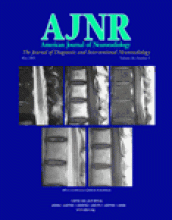Abstract
BACKGROUND AND PURPOSE: It is known that intracranial mass lesions are relatively isotropic on diffusion-weighted imaging. The purpose of this study is to report an unusually high fractional anisotropy (FA) and mean diffusivity (Dav) in the cavity of the brain abscess compared with other cystic lesions.
METHODS: We performed diffusion tensor imaging (DTI) in 12 patients with cystic intracranial lesions (pyogenic abscess, n = 5; cysticercus cysts, n = 2; and low-grade astrocytoma, n = 5). Mean FA, Dav from the lesion core, perifocal edema, and corresponding contralateral normal-appearing regions were measured and compared for relative changes in these parameters. In the abscess cases, we placed regions of interest on areas with FA >0.2 and FA <0.2 to get FA and Dav values.
RESULTS: There were two patterns of FA values in the abscess cavity in all five patients. Part of the abscess showed mean FA = 0.440 ± 0.135, with Dav = (0.993 ± 0.185) × 10−3 mm2/s, whereas other parts had FA = 0.131 ± 0.039 with Dav = (0.824 ± 0.183) × 10−3 mm2/s. The cystic tumors and neurocysticercosis showed very high Dav = (2.806 ± 0.25, 2.654 ± 0.35)× 10−3 mm2/s, with low FA = (0.108 ± 0.037, 0.08 ± 0.01), respectively.
CONCLUSION: Brain abscess cavity shows regions of increased FA values with restricted mean diffusivity compared with other cystic intracranial lesions. This information may prevent misinterpretation of the DTI information as white matter fiber bundle abnormalities associated with mass lesions.
- Copyright © American Society of Neuroradiology












